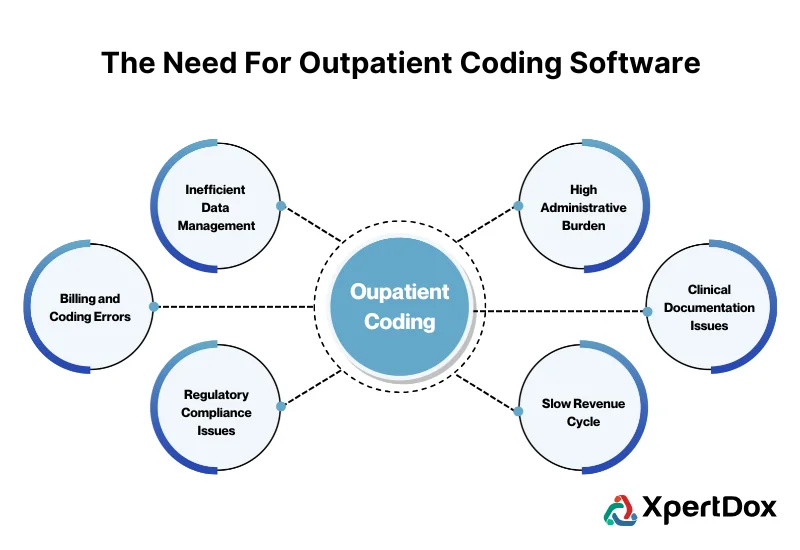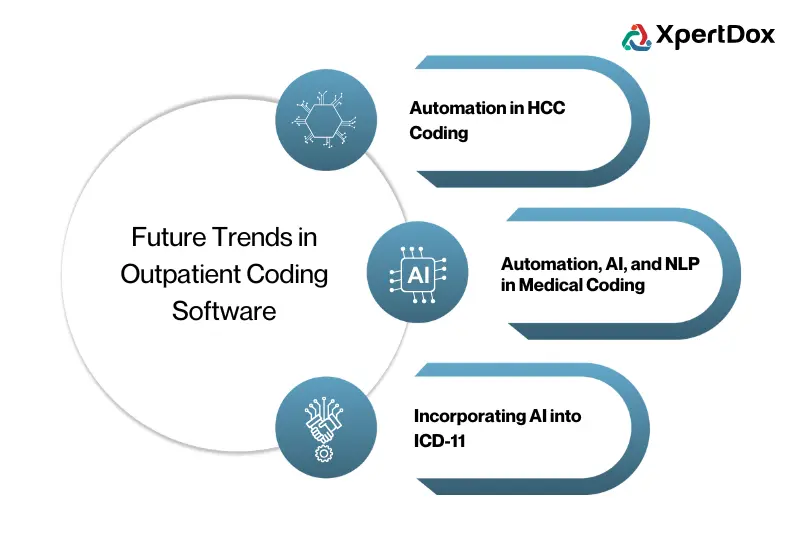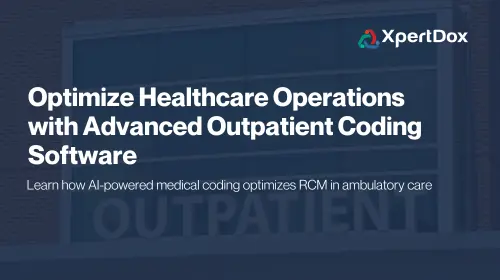For ambulatory care organizations, the stakes are high. Usually an ambulatory healthcare team needs to juggle patient care, billing, data management, and regulatory compliance daily. Without the right tools, these tasks can feel overwhelming, leading to errors, delays, and dissatisfied patients.
Fortunately, outpatient coding software isn’t just another tech tool. Designed to streamline operations, reduce errors, and improve the revenue cycle, an AI-based automated medical coding solution helps ambulatory care teams manage billing, documentation, and compliance with ease. With the right software, you can eliminate inefficiencies, improve accuracy, and focus on what matters most—delivering quality patient care.
What is an Outpatient Coding Software?
Outpatient coding software is a specialized tool designed to streamline the management of ambulatory care services. It automates the assignment of medical codes to patient diagnoses, procedures, and treatments, ensuring that each entry complies with standardized coding systems such as ICD-10, CPT, and HCPCS.
Here is an overview of what these systems are in Outpatient coding software.
| Coding System | Description | Usage |
|---|---|---|
| ICD-10 (The International Classification of Diseases, 10th Revision) | It is a comprehensive system for diagnosing and classifying diseases and conditions. | Used for diagnosis coding. |
| CPT (Current Procedural Terminology) | A set of codes used to describe medical, surgical, and diagnostic services and procedures performed by healthcare providers. | Used for procedure and service coding. |
| HCPCS (Healthcare Common Procedure Coding System) | It includes codes for products, supplies, and services not covered by CPT, such as durable medical equipment. | Used for coding non-physician services and products. |
This software connects seamlessly with electronic health records (EHR) and billing systems to help with accurate and efficient ambulatory medical coding, reducing the risk of errors and improving overall data quality.
Before diving deeper, understand the operational challenges you may face to see why outpatient coding software is crucial.
The Need for Outpatient Coding Software for Ambulatory Care
The U.S. medical coding market size is said to grow from USD 20.17 billion in 2023 to USD 41.99 billion by 2031. This highlights the importance of efficient coding solutions.
Operational challenges in the ambulatory healthcare sector can significantly hinder efficiency and patient care. Facilities often struggle with inefficient data management, leading to errors and delays. Billing and coding errors are common, causing claim denials and financial setbacks.

Understanding some of these operational problems is the first step toward finding effective solutions and improving overall performance. Here are a few issues to understand before adopting outpatient coding software.
- Inefficient Data Management: Manual and fragmented systems lead to data entry errors and slow access to patient information
- Billing and Coding Errors: Incorrect coding and billing can result in claim denials, delayed reimbursements, and financial losses
- Regulatory Compliance Issues: Keeping up with ever-changing healthcare regulations and standards can be overwhelming and prone to errors
- High Administrative Burden: Excessive paperwork and manual processes divert resources away from patient care.
- Clinical Documentation Issues: Gaps in documentation lead to recurring billing and coding errors, compliance risks, and inefficiencies in patient care, impacting both operational performance and reimbursement accuracy.
- Slow Revenue Cycle: Delays in claims processing and reimbursement hinder financial stability and cash flow.
Struggling with these operational challenges in healthcare? XpertDox’s autonomous medical coding can streamline data management, reduce billing errors, and ensure regulatory compliance. Enhance efficiency and patient satisfaction with our tailored solutions.
Having addressed the common challenges, it’s crucial to now turn your attention to the ten key features you should look for to ensure you select the right outpatient coding software.
Key Features to Look for in an Outpatient Coding Software
With the increasing complexity of medical coding and the need for compliance with ever-evolving regulations, choosing the right outpatient coding software becomes a critical decision.
The right software not only simplifies the coding process but also connects seamlessly with other systems, enhances accuracy, and provides valuable insights into performance. To ensure you select the best tool for your practice, here are ten key features to look for in outpatient coding software.
- Comprehensive Coding Library
A key feature in Outpatient coding software is a comprehensive coding library, including an extensive and current database of ICD, CPT, and HCPCS codes. Customizable codes for updates and specific needs are also valuable. - User-Friendly Interface
An intuitive, user-friendly interface enhances efficiency. Features like customizable dashboards simplify navigation and task management. - Connection Capabilities
Connects with EMR/EHR systems and billing systems and ensures smooth data flow and efficient claims submission. - Analytics and Reporting
Analytics and reporting features track performance, monitor coding accuracy and provide customizable reports for strategic planning. - Compliance and Updates
The software must comply with industry regulations and receive regular updates to align with coding guidelines and standards. - Security and Data Protection
Security features, including encryption and role-based access controls, protect patient data from unauthorized access. - Support and Training
Reliable customer support and comprehensive training resources are essential for the effective use of the software. - Scalability and Flexibility
Scalability and flexibility are important for growing practices, accommodating increased needs and varying specialities. - Free Trial Availability
A free trial allows users to evaluate the software's functionality and suitability before committing.
Benefits of Using an Automated AI-powered Outpatient Coding Software for Ambulatory Care
Managing outpatient coding manually — is frustrating and inefficient. An automated AI-based outpatient coding software solution automates the coding process and improves the operations for ambulatory healthcare services and organizations.
Explore how an automated outpatient coding software or service can elevate your practice and simplify your daily tasks.
- Increased Accuracy: Reduces coding errors and ensures precise data entry.
- Streamlined Billing Processes: Automates billing and reduces claim denials.
- Enhanced Compliance: Keeps up with regulatory standards and coding updates.
- Faster Claim Processing: Accelerates reimbursement cycles and cash flow.
- Improved Data Management: Centralizes patient data and simplifies access.
- Reduced Administrative Burden: Minimizes paperwork and manual tasks.
- Better Patient Care: Allows healthcare providers to focus more on patient care rather than administrative details.
- Real-Time Analytics: Provides insights and reporting for better decision-making.
- Scalability: Easily adapts to growing patient volumes and evolving practice needs.
- Customizable Solutions: Tailors features to meet specific organizational requirements.
- Enhanced Security: Protects patient data with advanced encryption and access controls.
- Reduced Training Time: User-friendly interfaces simplify staff training and adoption.
- Cost Efficiency: Lowers operational costs for ambulatory care services by reducing manual processes and errors.
Also Read: AI and Automation in Medical Coding.
While the benefits of using outpatient coding software are compelling, it's essential also to consider the challenges you may face during implementation.
Challenges in Implementing Outpatient Coding Software
Implementing an ambulatory specific coding software can offer significant advantages, but it’s not without its hurdles. From integrating with existing systems to ensuring compliance and security, several challenges can arise during the transition.
With approximately 34 million admissions reported across US hospitals so far in 2024, the pressure to streamline and optimize coding processes has never been greater.
Understanding these potential obstacles and how to address them is crucial for a successful implementation.
To help you with this process, here’s a table outlining common challenges along with practical solutions to overcome them.
| Challenge | Solution |
|---|---|
| Complexity of Software |
|
| High Initial Costs |
|
| User Resistance to Change |
|
| Data Migration Issues |
|
| Compliance with Regulations |
|
| Technical Difficulties |
|
| Customization Needs |
|
| Data Security Concerns |
|
| Scalability Issues |
|
Ready to overcome coding challenges? Discover how XpertCoding’s AI-driven approach streamlines medical coding for faster, more accurate claims and maximizes financial gains.
Future Trends in Outpatient Coding Software
As healthcare technology advances, so does outpatient coding. Future trends like blockchain, AI, and ICD-11 promise to enhance accuracy, efficiency, and security in coding.
Automation in HCC Coding
A key area where AI-driven medical coding makes an impact is Hierarchical Condition Category (HCC) coding. HCC coding is a risk-adjustment model that is designed to provide an estimated future health care costs for patients. By reducing errors and ensuring proper risk adjustment, AI-powered HCC coding enhances billing reliability, optimizes reimbursements, and helps healthcare organizations meet compliance standards effortlessly.

Automation, AI, and NLP in Medical Coding
Automation speeds up coding tasks, AI improves accuracy through machine learning, and NLP enhances AI’s ability to interpret medical records, reducing errors and improving billing reliability.
Incorporating AI into ICD-11
ICD-11, the latest standard for disease classification, benefits from AI integration. AI helps automate and improve code assignment using large datasets, ensuring precise documentation and alignment with global standards.
Conclusion
With future trends like AI on the horizon, medical coding is evolving fast. These technologies are set to enhance accuracy, streamline processes, and secure data, setting the stage for a new era in ambulatory care.
At XpertDox, we get that the stakes are high, and the process can be daunting. Let us help you simplify and perfect your coding with our advanced solutions. Ready to transform your outpatient coding experience? Book a demo with us today and watch how we can turn those coding challenges into success.
Published on - 02/18/2025
Want to learn more about XpertDox?
Frequently Asked Questions
-What is the primary function of outpatient coding software?
Outpatient coding software or an ambulatory coding software primarily automates the assignment of medical codes to patient diagnoses, procedures, and treatments within outpatient departments. It ensures compliance with standardized coding systems like ICD-10, CPT, and HCPCS, streamlining billing processes and reducing the risk of errors.
-What should I consider when choosing the right ambulatory coding software?
When selecting an ambulatory coding software, consider features such as a comprehensive coding library, real-time coding assistance, connectivity with existing EHR and billing systems, analytics and reporting tools, and robust security measures. Additionally, look for user-friendly interfaces and the availability of training and support to facilitate smooth implementation.
